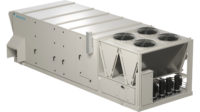Fast forward and that has all changed.
Over the years, commercial HVAC rooftop units have made great strides, thanks to market demands and technological developments. Advances in both light (3 to 25 ton) and large (above 25 ton) commercial packaged rooftop systems mean customers now have many options for higher performance, lower costs, and better indoor comfort and air quality. They are also built for easier installation and servicing, which saves the contractor time and money.

The Trane Voyager III commercial VAV rooftop unit is offered in sizes from 27.5-50 tons.
FLEXIBLE COMFORT CONTROL
About half of all U.S. commercial space is cooled by self-contained, packaged air conditioning units that sit on rooftops. These self-contained packaged units, including cooling equipment, air-handling fans, and also sometimes gas or electric heating equipment, are found on the tops of office buildings, retail centers, schools, hospitals, manufacturing facilities, and other building types.The units are much more flexible today than they were a generation ago. Single-zone low-pressure systems are still used for low-rise buildings with homogenous heating and cooling loads. But most newer commercial buildings and many retrofit projects are applying variable air volume (VAV) solutions to control loads to spaces with different heating and cooling needs.
The VAV rooftop unit regulates airflow and temperature to each facility area by providing constant airflow to a distribution system. The system has fixed supply air temperature but variable volumetric airflow to provide customized space conditioning. For example, a building with offices, laboratories, and a training theater can use VAV to meet the specific cooling demands of each area.
Not only does the system serve the facility’s varied HVAC needs, but it is more efficient than a single-zone system due to reduced fan energy consumption.
LIFETIME COST ANALYSIS DRIVES EFFICIENCY
Each year building owners and operators demand greater and greater HVAC efficiency as they become savvier about looking at lifetime costs versus first-time cost. HVAC equipment incurs most of its cost after purchase, through energy use and maintenance.There are a number of ways to achieve efficiency in rooftop units, from adding coil surface to applying the latest compressor technologies, such as scroll and twin-single compressors, staging compressors, or equipping them with variable speed advances.
Highly efficient fan motors are also extremely important to rooftop unit efficiency. Most of a rooftop’s power consumption is from the compressor, then the supply and condenser fans. However, because the fans often run to provide ventilation even when the compressor isn’t running, they can account for up to 45 percent of the equipment’s energy use.
Economizers, dampered cabinets that draw air from the outside when outside air is cooler than the inside temperature, can reduce energy use from 15 to 80 percent depending on the outside climate conditions.
Increasing rooftop unit efficiency not only reduces energy use, but also lowers peak usage time, which is power used during the hours when the energy grid suffers the greatest strain. Lower peak usage supports better energy management for the facility and also lessens environmental impact.
The rising importance of high-performance buildings also has had an impact on developments in rooftop unit efficiency. As more commercial facilities seek Leadership in Energy and Environmental Design (LEED) certification, and schools strive to meet high-performance standards (such as the Collaborative of High Performance Schools program in California), energy efficiency is taking top priority.
However, the greatest driver of HVAC equipment efficiency remains legislation. The 13 SEER federal mandate was just the start. Manufacturers are striving to offer ever higher efficiency levels to meet future mandates. In the light commercial sector, rooftop units that far surpass the 13 SEER rating are available.
These high efficiency rooftop units are helping all types of facilities, from commercial offices to retail centers and industrial buildings, meet regulatory standards, cut utility costs, and raise building performance. In some cases, facilities can also gain government incentives, adding to the payback.
Large commercial units are also gaining efficiency to meet 10 EER minimum, which is now required in several states. Technologies to gain efficiency for large commercial applications include evaporative cooling to replace air cooled condensers, and energy recovery, such as energy recovery wheels, which recycle energy to condition the air before it enters the building.

Shown is an installed Trane IntelliPak commercial rooftop unit. These units range in size from 20 to 130 tons.
AIR QUALITY CONTROL FROM THE TOP DOWN
In addition to high efficiency, rooftop units also provide ever higher levels of indoor comfort and IAQ performance.For example, rooftop units have made great advances in dehumidification. The demand for humidity control is on the rise as building owners and managers realize the costs associated with humidity problems. Pitfalls range from degraded equipment in data centers to performance problems among workers and students in uncomfortable conditions.
It is possible to achieve dehumidification in rooftop units through hot-gas reheat, which allows the compressor to provide reduced cooling at low loads. Other ways to control humidity include compressor staging and variable speed fan control.
Today’s rooftop units also allow for a much lower minimal airflow than units from generations past. This means less air runs across the coil for cooler air and consequent dehumidification. Desiccant dehumidification, which removes humidity from ventilation air, is another solution, which is especially suited to hospitals and schools.
Rooftop units today also offer features such as highly precise measurement of outside air circulation and CO2 sensors. These features help building managers to meet the ASHRAE 62 air quality standards.
SMARTER SYSTEMS FOR HIGH PERFORMANCE
There also have been many developments in rooftop unit ease of maintenance and seviceability. New generation units are much more reliable than they were in the past, and have longer lifetimes. They are also available in more compact designs and made with weather-resistant panels, with hinges and latches for easy access. Some units also come equipped with electronic panels. These improvements cut service time for contractors and increase safety.The transition from mechanical controls to electronic controls has made HVAC systems smarter and better performing, with features to control efficiency, indoor comfort, and critical cooling capabilities. Units are available with on-board diagnostics to assist with troubleshooting and make for faster service times. Building management system panels installed on the rooftop units are available to provide tracking and monitoring on an integrated communications system. This allows the contractor to offer more options to meet customers’ HVAC needs.
Rooftop units are not what they used to be. And they will continue to develop to meet the changing demands and specifications of the industry.
Sidebar: New Construction Tips
•Beware of outdated airflow rules of thumb.Over the years commercial rooftop manufacturers have raised the bar on typical airflow and cooling operating envelopes. For example, a few years ago, the typical airflow was measured at 400 cfm/nominal ton. Now manufacturers have pushed beyond typical airflows (some down to 200 cfm/nominal ton). This allows for increased coincidental dehumidification and increased outdoor air ventilation.•Avoid oversizing cooling.Oversizing the cooling load can create potential humidity issues in the space due to rapid cycling of the compressors. The compressor needs enough time to stay on to allow for the unit to perform dehumidification.
•Know heating load requirements.Make sure to consider location and heating requirements for your region or area. It is important to size the heating load accurately regardless of type of heating (gas, mechanical heat pump, or electrical).
•Remember importance of wire size.Make electrical considerations for wire size. The electrical wire size is determined by the NEC (National Electrical Code) and the equipment MCA (minimum circuit ampacity).
•Make considerations for noise.Always enact good engineering practices when making considerations for indoor sound. Consider duct wraps, T-drops, thicker gauge material, and unit location when designing for commercial rooftops.
Sidebar: Replacement Construction Tips
•Consider efficiency ratings (SEER/EER).Rooftop efficiencies have gone up over the past 10 years, creating more potential payback for the customer. Always consider the efficiency rating when replacing equipment. Utility payback programs along with higher efficiency equipment can be an excellent way to reduce energy consumption.•Make considerations for airflow (static pressure).Do not assume all ductwork is the same. The project could have changed or the structure has changed to allow for different static pressures.
•Make indoor lighting upgrades.Consider indoor lighting upgrades. Over the years, indoor lighting has become more efficient. These upgrades can actually reduce the indoor building load. When replacing like tonnages for like tonnages, this could potentially put the building in an oversize situation and create humidity issues. Always take into consideration the new building load.
•Ensure correct electrical wire size.When replacing like tonnage models always be sure to consider the wire size for replacement units.
Publication date:04/23/2007







